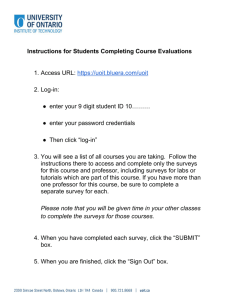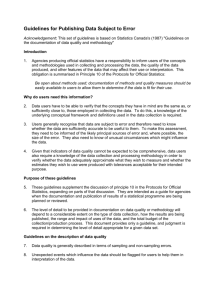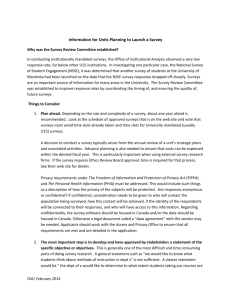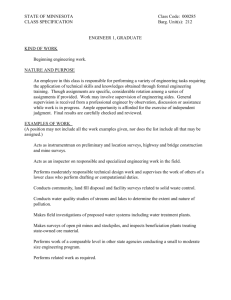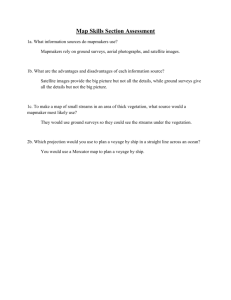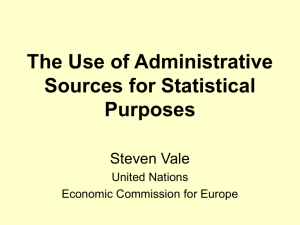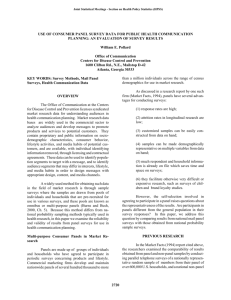Global Market Research: Strategies & Methods
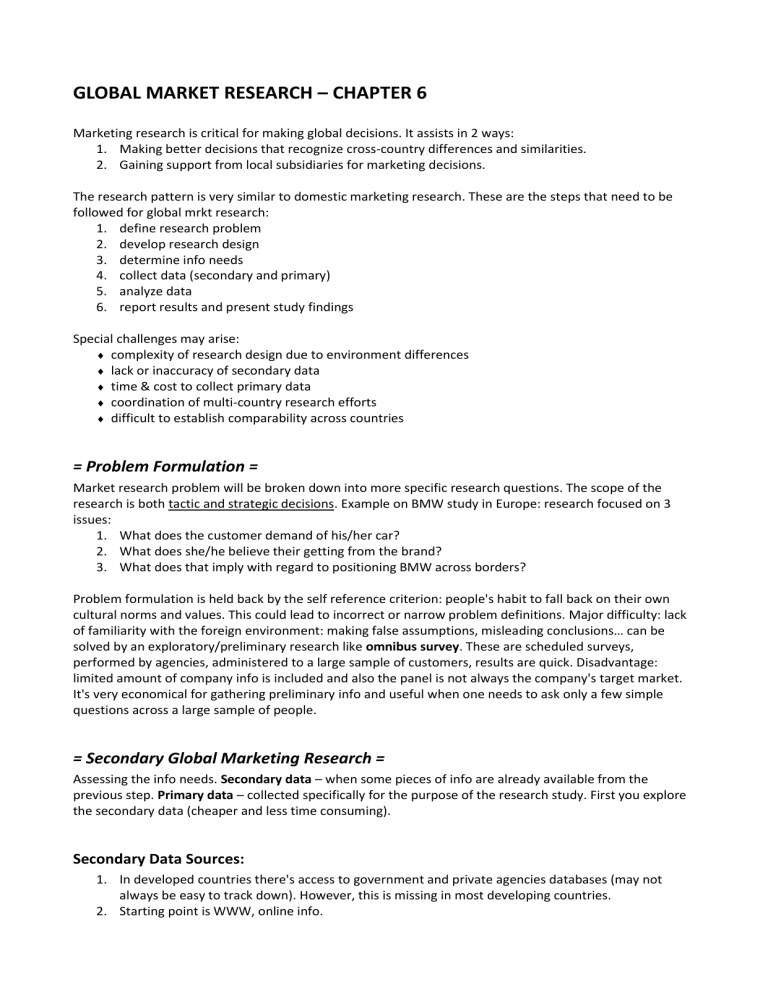
GLOBAL MARKET RESEARCH – CHAPTER 6
Marketing research is critical for making global decisions. It assists in 2 ways:
1.
Making better decisions that recognize cross-country differences and similarities.
2.
Gaining support from local subsidiaries for marketing decisions.
The research pattern is very similar to domestic marketing research. These are the steps that need to be followed for global mrkt research:
1.
define research problem
2.
develop research design
3.
determine info needs
4.
collect data (secondary and primary)
5.
analyze data
6.
report results and present study findings
Special challenges may arise:
complexity of research design due to environment differences
lack or inaccuracy of secondary data
time & cost to collect primary data
coordination of multi-country research efforts
difficult to establish comparability across countries
= Problem Formulation =
Market research problem will be broken down into more specific research questions. The scope of the research is both tactic and strategic decisions. Example on BMW study in Europe: research focused on 3 issues:
1.
What does the customer demand of his/her car?
2.
What does she/he believe their getting from the brand?
3.
What does that imply with regard to positioning BMW across borders?
Problem formulation is held back by the self reference criterion: people's habit to fall back on their own cultural norms and values. This could lead to incorrect or narrow problem definitions. Major difficulty: lack of familiarity with the foreign environment: making false assumptions, misleading conclusions… can be solved by an exploratory/preliminary research like omnibus survey. These are scheduled surveys, performed by agencies, administered to a large sample of customers, results are quick. Disadvantage: limited amount of company info is included and also the panel is not always the company's target market.
It's very economical for gathering preliminary info and useful when one needs to ask only a few simple questions across a large sample of people.
= Secondary Global Marketing Research =
Assessing the info needs. Secondary data – when some pieces of info are already available from the previous step. Primary data – collected specifically for the purpose of the research study. First you explore the secondary data (cheaper and less time consuming).
Secondary Data Sources:
1.
In developed countries there's access to government and private agencies databases (may not always be easy to track down). However, this is missing in most developing countries.
2.
Starting point is WWW, online info.
3.
Next, tap into the company's databanks, libraries.
4.
Look into international agencies such as World Bank, the United Nations…
5.
Companies who specialize in providing business related info (expensive).
6.
Syndicated data sets sold by market research companies.
Problems with secondary data research
Accuracy of data: definitions for indicators differ across countries. Different methods of collecting data damage its quality. Significant facts such as cross-border smuggling aren't covered by international trade statistics.
Age of data: data can be available but outdated.
Reliability over time: to study trends, a company sometimes needs historical info. How consistent is
the data measurements over time?
Comparability of data: different sources can produce contradictory info. One way to handle this is
triangulate = obtain information on the same item from 3 different sources (at least) and speculate on possible reasons behind the differences. Another reason for bad comparability is a lack of
functional/conceptual equivalence (conceptual equivalence = similar products in different countries
fulfill the same functions).
Lumping of data: official data sources often group statistics on certain variables in very broad categories.
Assessing the quality of the data:
1.
When was it collected? Over what timeframe?
2.
How was it collected?
3.
Have the variables been refined over time?
4.
Who collected?
5.
For what purpose wad the data collected?
= Primary Global Marketing Research =
Primary data can be collected in several ways:
1.
focus groups
2.
survey research
3.
test markets
We concentrate on the first two.
Focus groups
A focus group is a loosely structured free-flowing discussions among 8-12 people of target customers. Can be used for:
1.
Generating info to guide the project
2.
Reveal new product opportunities
3.
Test new products
4.
More…
Moderators should be familiar with the local language and social life and also be very cultural sensitive. To stimulate group dynamics:
Be precise in recruiting to ensure group homogeneity and bonding.
Hire moderators who can quickly develop group dynamic with warm-up, humor and role-playing.
Hire moderators who can spot and challenge consensus behaviors.
Concentrate on nonverbal cues.
Survey methods for cross cultural Marketing Research
Questionnaires are the most common. Includes several stages:
1.
Design: preparing questionnaires for global study has some challenges – a.
Ensure measurement comparability of survey based results b.
Fulfill two criteria: i.
Translation – of the instrument. Methods to avoid sloppy translations are back and
parallel. Back is a two phase process translating the document back and forth.
Parallel is using several translators who do the job separately and then comparing. ii.
Scalar equivalence – when using a scale. Scores from subjects from different countries should have similar meanings and interpretation. c.
In developing countries with low level education sometimes use "funny-face scale" with pictures and reduce the verbal content. d.
Pretest the questionnaire to debug it and spot embarrassing/expensive mistakes.
2.
Sampling Plan: drawing a sample from the target population. a.
Sampling unit: what is the target population? b.
Sample size: how many people should be surveyed? i.
Heterogeneous cultures (India) demand a larger sample size than homogeneous cultures (Thailand). c.
Sampling procedure: how should prospective respondents is chosen from the target population? d.
Determine these issues by balancing costs, requirements and time. e.
Decide what countries to research. Two approaches: i.
Large scale exploratory research covering many countries. ii.
Focus on key countries. To choose you need to group countries into categories and then pick one or two from each cat.
3.
Contact Method: how to contact the subjects of the survey? Most common: a.
Mail b.
Telephone c.
Interviews
Depends on:
Cultural norms – in Saudi Arabia, daytime telephone surveys won't work because the
Cost differentials – between these methods
women don't answer the phone… in Japan when it comes to Business-to-Business issues they prefer not to discuss it over the phone.
Lack of marketing research infrastructure: o Mail service o Phone service o Internet access
Three types for online surveys: o E-mail surveys – self administered questionnaires, sent as attachments. o Website surveys – visitors at the site are asked to fill questionnaires. Popup surveys also common. o Panel website surveys – relay on a panel of respondents in which each member receives the survey by email.
Pros for online surveys: o Large samples in short time o Global access to internet o Cheap o Anonymous o Data is directly loaded onto the database for analysis
Cons for online surveys: o Infrastructure – some countries have low internet access o Time to download web-pages
o Technical problems: incorrect emails, connections… o Low response rate o Multiple responses from the same person
4.
Collecting the info: the most severe problem would be non-response due to lack of trust, fears from confidentiality etc. o Courtesy bias – desire to be polite to the other person, obligated to respond and please the interviewer. o Social desirability bias – the subject attempts to reflect a certain social status in his answers. o To overcome these challenges: need trained and experienced interviewers and supervision. o Redundancy: when developing a survey, ask same questions in a different way. o Ethnographic research – less conventional method. Gathering relevant information by participating in everyday life of the people being studied.
= Market Size Assessment =
One of the key drivers for deciding whether to entry a country or not is the potential. This section introduces four methods to assess market size for any given product:
1.
Analogy Method (page 211 if it's not clear enough):
Picking a country that's the same stage of economic development as the country of interest and for which the market size is known. Example: i.
Estimating the market size for DVD players in Ukraine by comparing it to Poland
(because we have info about Poland…) ii.
Choosing a variable that correlates, like: the number of color TV in use. iii.
Assume roughly: is equal in both countries. iv.
From here on you can simply calculate the demand in the Ukraine market based on the numbers you have for Poland… v.
Sometimes the analogy exists in different time periods, so:
M 2008
B
= X 2008
B
* (M 1998
A
/ X 1998
A
)
M= market size of the product
X= the correlating variable
A= country
B= country vi.
Can produce misleading information when:
1.
consumption patterns aren't the same
2.
competition, trade barriers and other factors are different
3.
technological advances allow innovations at an early economic stage
2.
Trade Audit i.
Based on local production and import, export figures for the product of interest. ii.
Straightforward logic:
Market Size in country A = Local Production + Imports – Exports
3.
Chain Ratio Method i.
Start with a rough base (entire country population) and fine-tune using a chain of percentages. ii.
Example: Nicotine gum in Japan (2002):
1.
entire Japanese population: 127 million
2.
smoking rate in Japan: 31%
3.
ages 15-64 (from entire population): 67.5%
4.
From here we can estimate the number of adult smokers which are the target market for the product.
4.
Cross-Sectional Regression Analysis - Market size is related to a set of predictor variables.
1.
Choose a set of related indicators
2.
Collect data on these variables for a number of countries
3.
Fit a regression that allows market size prediction.
5.
Rules you need to follow for the methods above: i.
Use several methods to relay on different data & inputs ii.
Make sure you know the meaning behind the numbers iii.
Use simple methods, sophistication can lead to lack of accuracy iv.
Ask what-if questions when making assumptions v.
Look for lower and upper limits, not only estimates. The range indicates the precision of the estimates.
= New Market Information Technologies =
Point-Of-Sale (POS) store scanner data: obtaining sales data from the checkout scanner of retail stores.
This data provides weekly info about shifts in sales, brands, sizes… these shifts can be related to changes in the store (price, display…) or competitive environment.
Consumer Panel data: two approaches: o Panel members present ID card when checking out at the cash register o Scanning at home when returning from a shopping trip
Single-Source data: combines TV viewing behavior with purchase transactions. Allows companies to measure the effectiveness of their advertising.
Major developments in marketing:
Shift from mass to micro marketing: new technologies enable companies to tailor pricing, products, advertising and promotion. Marketing database allows direct contact with the customers. Example:
Nestle built a database for pasta consumers by registering them to get a free cooking magazine. The goal from there was to continue to build with them a long-term commitment…
Continuous Monitoring of brand sales/market share movement.
Scanning data by manufacturers to support marketing decisions. not only as tracking devices, but also
for inventory management, pricing, shelf-space…
Scanning data to provide merchandising support to retailers
Despite the promise of scanner database, many countries haven't exploited this into full potential, and still use this only as tracking device. Why?
1.
Conservatism of the users of the data.
2.
Attitude of local retailers toward data access.
= Management of Global Marketing Research =
Selecting a research agency
The selection is made by the company headquarters or the local/regional headquarters. In some countries relaying on local research firms is a must (China). They have a network of contacts, they know how to get around government regulations, etc.
What type of research service do they give?
Agencies that are subsidiaries to global research firms are very useful when you need to coordinate cross-country research efforts.
Level of expertise o Qualifications of the staff o How long is it in business o What types of problems has it dealt with o Who are its clients o Confidentiality reputation
Communication skills
Any possible conflicts – does the agency have any ties with competitors?
Costs. Multiple translations, coordination and long-distance project management.
Golden rule: beware of agencies that promise the world at a bargain price!
Coordination of Multi-Country Research
Coordination facilitates the following:
1.
Cross-country comparison of results
2.
Centralization of communication and quality control
3.
Two key issues: a.
Who does the coordination? The agency or the company? b.
What should be the degree of coordination? Headquarters usually prefer standardized data collection while local groups favor county-customized research design. This is called the
emic vs. etic dilemma. (Emic= the peculiarities of each country. Etic= universal behavior).
Several approaches to balance between the two. Let's look at what BMW did: i.
All relevant parties were included in the planning part or the project (headquarters and local subsidiaries). ii.
All parties contributed to fund the study. iii.
Hypotheses and objectives were deemed to be binding at a later stage. iv.
Data collection by 2 stages:
1.
First: country-specific responses
2.
Finally: standardized survey instruments (with a few customized statements).
4.
Coordination means that all parties should be involved
5.
Multi-country research should allow some flexibility for country peculiarities.


